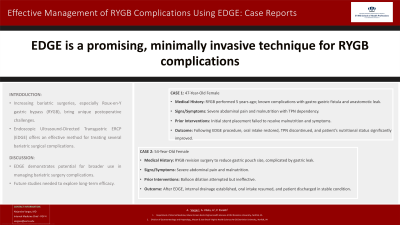Monday Poster Session
Category: Interventional Endoscopy
P2798 - Effective Management of RYGB Complications Using EDGE: Case Reports
Monday, October 28, 2024
10:30 AM - 4:00 PM ET
Location: Exhibit Hall E

Has Audio

Alejandra Vargas, MD
Eastern Virginia Medical School
Norfolk, VA
Presenting Author(s)
Alejandra Vargas, MD, Ana Vilela, MD, Parth Parekh, MD
Eastern Virginia Medical School, Norfolk, VA
Introduction: The past decade has witnessed a substantial rise in bariatric surgeries, particularly Roux-en-Y gastric bypass (RYGB), owing to its safety profile, low morbidity, and minimal mortality rates. With the increasing number of procedures, gastroenterologists frequently encounter variant postoperative anatomies and complications. Endoscopic ultrasound-directed transgastric ERCP (EDGE) could be a reliable and effective method for treating several bariatric surgical complications. This abstract presents cases of anastomotic strictures managed through EDGE.
Case Description/Methods: We discuss the cases of two female patients who experienced complications after undergoing RYGB.
Case 1: A 47-year-old woman with a history of RYGB complicated by a gastrogastric fistula and anastomotic leak. Subsequently, she developed a gastrojejunal stricture, making her dependent on total parenteral nutrition (TPN). Despite initial stent placement, she was readmitted due to severe protein malnutrition and abdominal pain. The EDGE procedure was performed, placing a lumen-apposing metal stent to enhance oral intake and eliminate the need for TPN. Following this intervention, the patient successfully discontinued TPN.
Case 2: A 54-year-old woman with a history of RYGB underwent revision to reduce the size of her gastric pouch and gastrojejunostomy, which was complicated by a gastric leak. This necessitated the insertion of a G-tube into the gastric remnant and an abdominal washout. Subsequently, she developed edema and congestion at the gastrojejunal anastomosis, causing gastric outlet obstruction. Balloon dilation was deemed ineffective, so the EDGE procedure was utilized, and a lumen-apposing metal stent was placed to facilitate internal drainage from the gastric pouch to the gastric remnant. This intervention allowed the patient to resume oral intake, and she was successfully discharged.
Discussion: The EDGE technique could be a minimally invasive, effective, and cost-efficient solution for managing certain complications associated with RYGB. These cases highlight its potential to address the unique challenges posed by RYGB anatomy and its associated complications, demonstrating its clinical utility and versatility.
Disclosures:
Alejandra Vargas, MD, Ana Vilela, MD, Parth Parekh, MD. P2798 - Effective Management of RYGB Complications Using EDGE: Case Reports, ACG 2024 Annual Scientific Meeting Abstracts. Philadelphia, PA: American College of Gastroenterology.
Eastern Virginia Medical School, Norfolk, VA
Introduction: The past decade has witnessed a substantial rise in bariatric surgeries, particularly Roux-en-Y gastric bypass (RYGB), owing to its safety profile, low morbidity, and minimal mortality rates. With the increasing number of procedures, gastroenterologists frequently encounter variant postoperative anatomies and complications. Endoscopic ultrasound-directed transgastric ERCP (EDGE) could be a reliable and effective method for treating several bariatric surgical complications. This abstract presents cases of anastomotic strictures managed through EDGE.
Case Description/Methods: We discuss the cases of two female patients who experienced complications after undergoing RYGB.
Case 1: A 47-year-old woman with a history of RYGB complicated by a gastrogastric fistula and anastomotic leak. Subsequently, she developed a gastrojejunal stricture, making her dependent on total parenteral nutrition (TPN). Despite initial stent placement, she was readmitted due to severe protein malnutrition and abdominal pain. The EDGE procedure was performed, placing a lumen-apposing metal stent to enhance oral intake and eliminate the need for TPN. Following this intervention, the patient successfully discontinued TPN.
Case 2: A 54-year-old woman with a history of RYGB underwent revision to reduce the size of her gastric pouch and gastrojejunostomy, which was complicated by a gastric leak. This necessitated the insertion of a G-tube into the gastric remnant and an abdominal washout. Subsequently, she developed edema and congestion at the gastrojejunal anastomosis, causing gastric outlet obstruction. Balloon dilation was deemed ineffective, so the EDGE procedure was utilized, and a lumen-apposing metal stent was placed to facilitate internal drainage from the gastric pouch to the gastric remnant. This intervention allowed the patient to resume oral intake, and she was successfully discharged.
Discussion: The EDGE technique could be a minimally invasive, effective, and cost-efficient solution for managing certain complications associated with RYGB. These cases highlight its potential to address the unique challenges posed by RYGB anatomy and its associated complications, demonstrating its clinical utility and versatility.
Disclosures:
Alejandra Vargas indicated no relevant financial relationships.
Ana Vilela indicated no relevant financial relationships.
Parth Parekh indicated no relevant financial relationships.
Alejandra Vargas, MD, Ana Vilela, MD, Parth Parekh, MD. P2798 - Effective Management of RYGB Complications Using EDGE: Case Reports, ACG 2024 Annual Scientific Meeting Abstracts. Philadelphia, PA: American College of Gastroenterology.
